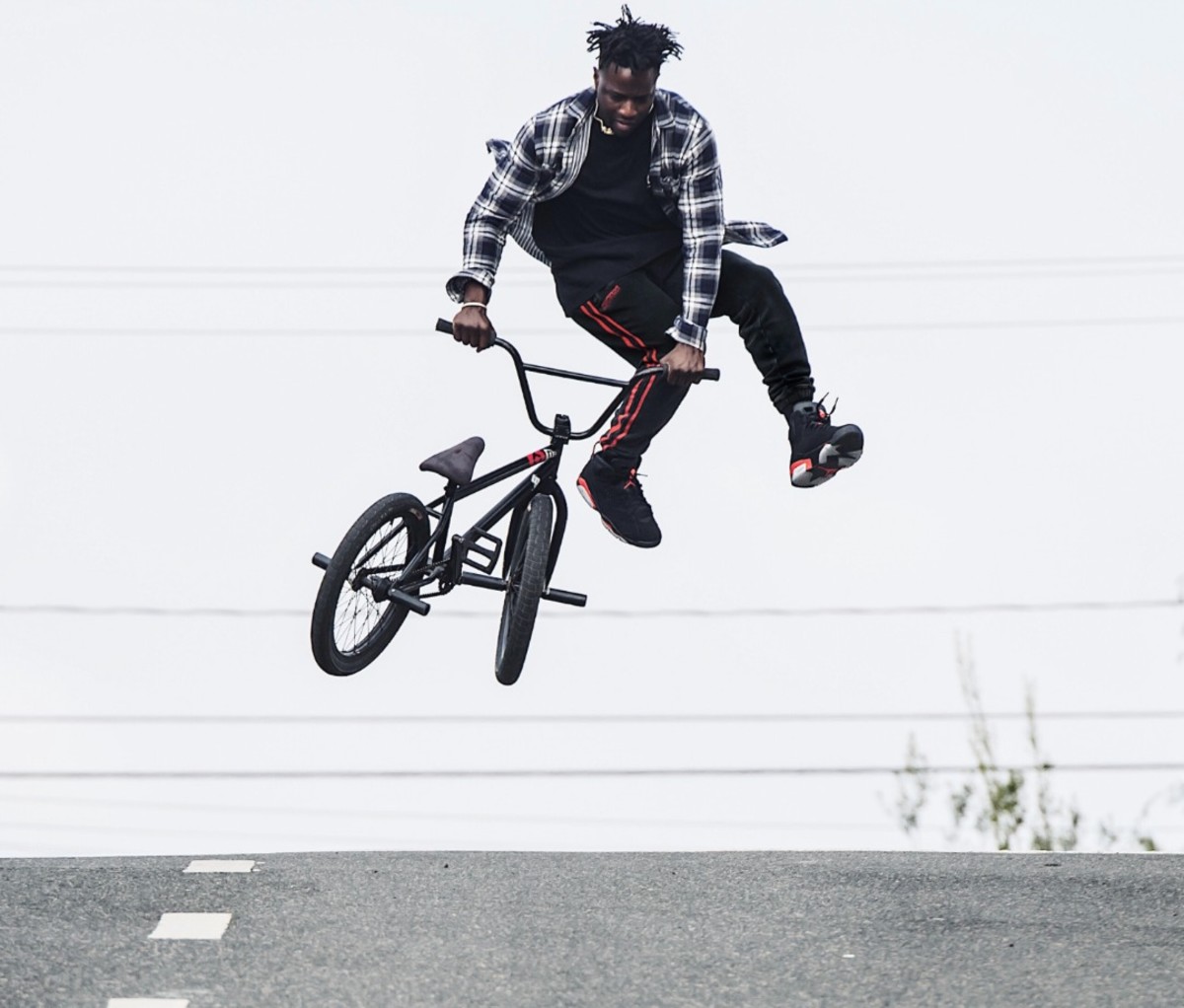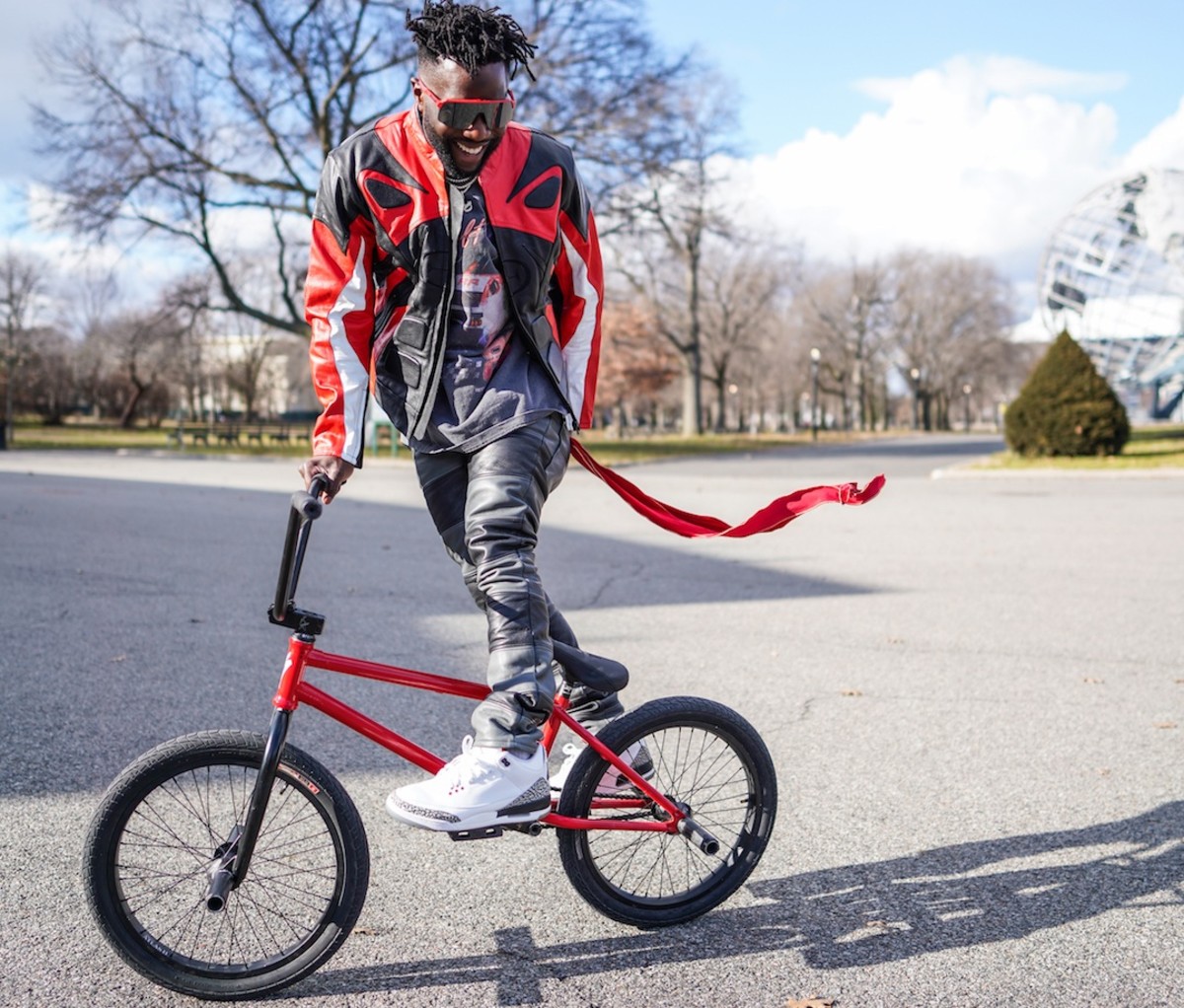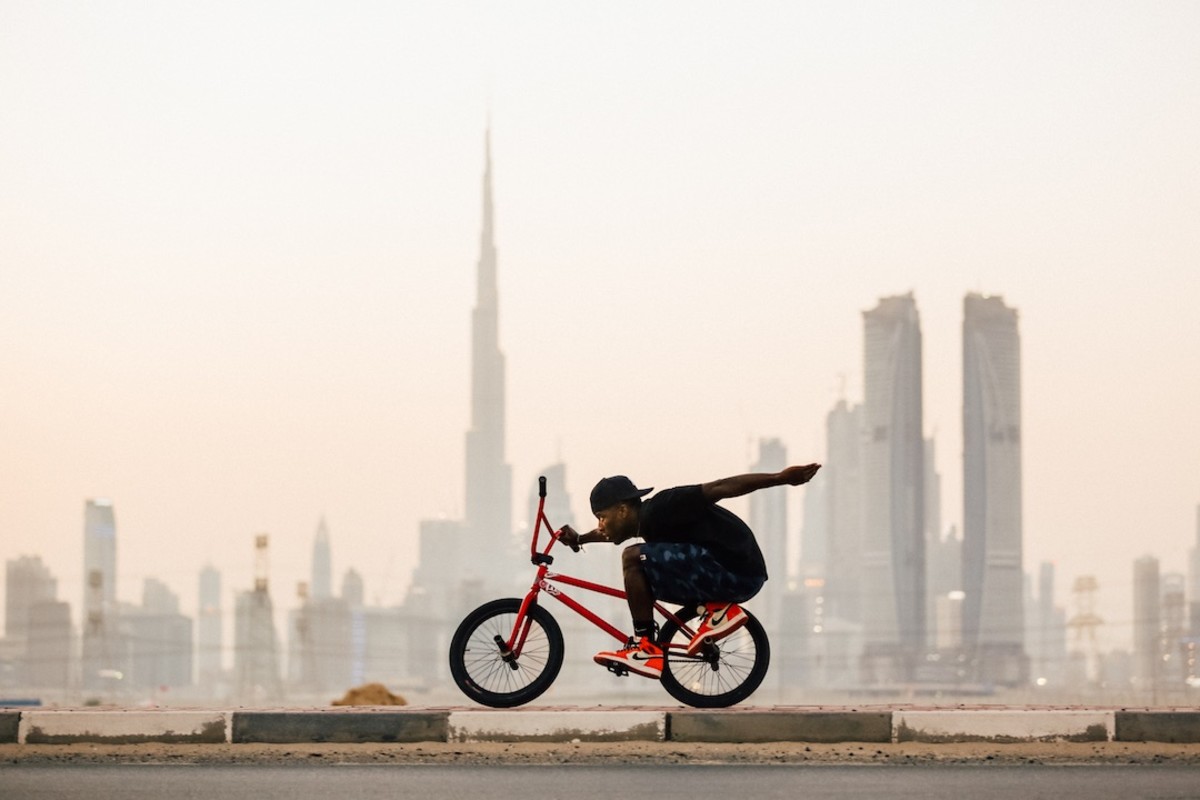Look at any list of BMX icons and you’ll notice one common factor: They’re all white. From Dave Mirra to Mat Hoffman to Ryan Nyquist, the sport’s top performers and biggest celebrities over the last 40 years all share a similar story, culture, and lifestyle. Slowly yet noticeably, that’s starting to change.
BMX pro Nigel Sylvester doesn’t fit the mold. He didn’t grow up competing in conventional BMX contests. There was never a clear-cut path into the industry. And charting his own also meant never dressing like other riders, following industry trends, or having the access that other stars tapped. But, as he’ll tell you, Sylvester didn’t let a lack of obvious opportunities determine his chase for the dream of becoming a professional BMX athlete—his way, by his own rules.
Sylvester grew up in Laurelton, Queens, NY. The streets were his playground and continue to be the foundation of his riding style—his muse, if you will. There, Sylvester’s identity, influenced heavily by hip-hop, fashion and his love for vivid visual expression, is reflected in his content. Alongside his friends, he would hone his craft at local parks by jumping on and off benches, or at local churches or schools where he would grind handrails and waxed ledges, and from time to time, create makeshift ramps. Sylvester says this formative exploration taught him that bicycle riding provides freedom, instills confidence, and is an outlet for true self-expression.
We sat down with Sylvester to learn more about his childhood, his unique path to becoming one of the most iconic professional BMX athletes in the world, his entrepreneurial endeavors, his work as a model, and his greater contributions to his community. (The interview is edited lightly for clarity.)
Men’s Journal: When did you start riding BMX and what were those early days like?
NIGEL SYLVESTER: I grew up riding all types of bicycles from an early age. I believed that if I put enough energy and time into riding, I would achieve some level of success. The goal was to bring my ideas and dreams to life. I saw other athletes, artists, and musicians coming from similar situations as me, turning their craft into reality. So, I stuck with BMX riding at a time when the path wasn’t clear, but the love was.
At that point, street riding was quickly becoming the most popular form of BMX. Most riders that I hung out with weren’t concerned with riding in the big contests because, at the time, most of the big contest series didn’t come to New York or cater to our style of riding. Beyond that, access to training at the facilities to prepare for that type of riding was expensive and wasn’t realistic for my situation. Instead, I focused on filming clips for video features, which were showcased in the latest DVDs and led to good exposure.
Around 15 years old, it started to crystallize for me, and I wholeheartedly believed I could achieve my goal of becoming a professional BMX athlete on my terms. From the beginning, I treated each stunt, each video, as a form of expression; a piece of art. By sticking to that and staying true to my vision, doors slowly started to open. I had the opportunity to work with BMX legend Dave Mirra who signed me to a professional contract at 18, to his bike company, MirraCo. Bicycles. Then a sneaker deal with Nike came along, and I slowly began to understand how the business of the industry worked.

How has the BMX world changed since you got started?
It’s changed drastically. When I started riding BMX, there were only a few outlets to gain notoriety: BMX magazines, DVDs and VHS videos. If you made it to the highest level, you rode in a contest that got broadcasted on TV a couple of times a year. Nowadays, with advancements in technology, kids can post their tricks and content on social media, which has led to the bar being raised rapidly. The power is now in the hands of the athletes and content creators. We control our narrative and tell our stories the way we see fit.
Was there any diversity in BMX when you got started? What challenges came with being an African American BMX rider?
I grew up in a predominantly Black neighborhood, and almost all my friends who rode BMX were Black, but that wasn’t what we saw reflected most of the time in the BMX media or publications. It was weird for me early on; before I turned pro, I was pursuing a sport that everyone around me perceived as a white sport, which came with its challenges. When I got into the industry and started rising amongst the ranks, I began to show my style and outlook more because I had the platform to do so, which caused some friction. Not many people or industry insiders understood or agreed with my approach. There were many times that I experienced racism and stereotypes as a Black pro BMX athlete who was infusing hip-hop, art, and fashion the way I did, which began to break the traditional mold.
What is it going to take to make biking more inclusive?
Honestly, it’s happening as we speak. Around the world, you see kids from various walks of life riding BMX bikes—stunting—with hopes and dreams of one day going pro. BMX in the early ’90s is not what it is now, so many people are still holding onto those old ideas of the sport. Changing that starts with exposing and educating audiences through content and by telling more diverse cycling stories.

What does the American dream mean to you?
I am the modern-day American dream. Both of my parents were immigrants from Grenada and came to the States for a better life. They sacrificed everything for my brother and me. I’m talking about countless shifts that they worked to provide the necessities. Through their sacrifice, I learned what hard work and dedication are to provide for your loved ones. That laid the foundation for me to pursue this dream of riding bikes on a professional level. That’s what the American dream is based on; in my opinion, it’s pursuing a challenging goal to provide access and resources for the next generation in your family. If you accomplish it, your life changes for the better, and you gain a sense of purpose and joy.
The next step is paying it forward and giving it back. My mom in particular has given up so much and she was the one that instilled the idea of charity into me. She held up that promise. So I’m doing what I can to support and provide for people around me. Pulling people up with me. I’m in a lucky and pivotal place in my life and career to make these decisions.
What was the original idea behind GO? Where is it now and where do you see it going?
I started GO at a point in my career where I wanted to expand my brand. The idea to ride my BMX bicycle around the world was very attractive, and we knew we could create a platform that would be impactful. We developed a formula that allowed us to document my journey through any city or location creatively. The goal was to seamlessly connect all of the elements I interact with on my daily adventures—the people, culture, sights, sounds, products, etc. We developed something that didn’t exist at the time, and it became a success.
We produced the first installment in NYC on a shoestring budget. Shooting it from my POV allowed a deeper level of connectivity. It was the closest I’ve ever brought viewers to the feeling I get when I’m out riding. GO has resonated with audiences worldwide because we were able to share the love of riding, travel, and discovery authentically.
The GO series is currently in a great space with over 80 million views worldwide. We now have six installments of the series completed and gearing up to produce our seventh installment this year. We’re in the process of developing the GO apparel, and once COVID-19 is more under control, we’re hoping to do live events. We’ve reached a point where we’ve developed a global community of people who love the GO brand. Our fans and supporters love the energy and vibe that the brand delivers. GO embraces individuals and people from all walks of life who dream vividly, aren’t afraid to roll the dice, and dedicate themselves to achieve what fulfills them.

How much did COVID change your lifestyle, plans, and outlook?
Everything my team and I were working on got put on hold, like the rest of the world. I took the downtime to reflect on how I can improve in every aspect of my life. Many people and families worldwide were greatly affected, which is a tragedy; this pandemic was a real thing. I’m thankful and fortunate that I’m safe and my family is good. I hope we’re a better society and world post going through such a traumatizing moment in time.
You’re a pro BMX rider, model, activist, and entrepreneur. How do you balance all of these?
I’m a BMX athlete through and through until the wheels fall off, and that will never change. Pushing myself on my bike, pursuing business opportunities, and building brands, modeling for some of the world’s biggest fashion houses, and serving my community is a part of who I am and critical to what fulfills me. I never wanted only to ride bicycles because I’m passionate about many other things.
I have the ability to do this and I want to embrace this moment. It’s all a way to express myself. Doing this on a bike is second nature but there are other ways too. I want to use my platform to highlight issues that are important to me.
You’re a big part of Bike Rides 4 Black Lives, where is that organization right now?
We’re working on it behind the scenes right now. Systemic racism should have been dealt with years ago, but clearly it hasn’t. BR4BL is a great way to use biking to highlight these issues. COVID shut down big events, so recently we’ve been working on adjusting the platform. Still planning a few rides this year.
from Men's Journal https://ift.tt/3cWxegE





0 comments